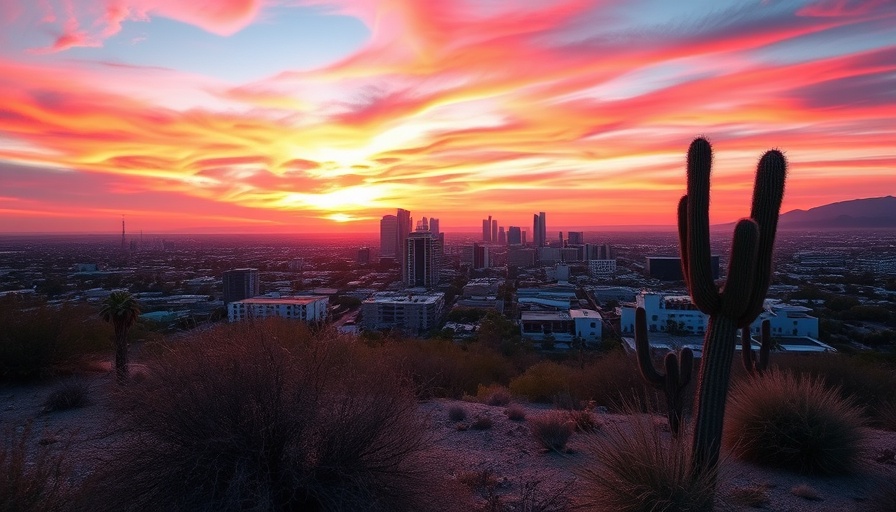
Exploring the Driest Cities in America: A Unique Perspective
As we look at the landscapes of the United States, a number of cities grab attention for their notably arid climates. Characterized by scant rainfall and expansive desert vistas, these locations represent a lifestyle that contrasts sharply with regions defined by lush greenery and moisture. The driest cities in the U.S. elevate the charm of sun-soaked days while presenting real challenges tied to drought and water scarcity. With warmer temperatures enticing many to relocate, it's important to consider what living in these arid environments truly entails.
Understanding the Metrics: What Makes a City 'Dry'?
The ranking of these dry cities primarily leans on two measurable factors: annual precipitation totals and average humidity. Analyzing cities based on their annual average precipitation, we find that many hallmark dry locations are nestled within the Southwestern states. These areas, while providing picturesque sun-filled skies, often struggle with long-term sustainability challenges. This creates a dichotomy for potential residents weighing the allure of sun-drenched climates against the potential ramifications of such arid living.
The Top Driest Cities: Where Water is Scarce
Leading the pack, Yuma, Arizona secures its position as the driest city in the U.S. with an astonishing average annual precipitation of only 3.2 inches. Known as the "Winter Salad Bowl Capital," Yuma's agricultural prowess enables it to thrive despite its desiccated environment. Following closely behind are Lake Havasu City, Las Vegas, and Bakersfield, each with their own unique attraction for residents and tourists alike.
While the sun-drenched landscapes might appeal during chilly months, the harsh summers can be daunting, making water security a pressing concern. Empirical data suggests that these cities are not just a dream destination but also a call to action regarding responsible living in water-scarce areas.
The Economic Impact of Living in Dry Cities
Economically, cities like Yuma and Las Vegas offer a vibrant real estate market driven by the sun-seeking populace. With a surge in people relocating to these dry climates, there is an uptick in housing demand, creating a wealth of possibilities for real estate agents, property investors, and potential homeowners. Whether you're browsing through platforms like Zillow or Redfin or considering the local real estate agencies, the landscape presents ample opportunities for investment.
People's Perception: The Allure of Arid Living
Residents enjoy a different lifestyle marked by outdoor activities ranging from hiking to exploring vast desert landscapes. However, this dry environment also brings unique challenges. Those contemplating a relocation should not only appreciate the warmth but also the implications of living in such environments. Water conservation becomes a vital part of daily life, fundamentally altering one's relationship with nature and community resources.
Future Trends: Climate Changes and New Realities
As climate change continues to reshape our environment, the forecast for these arid regions is dual-faceted: while they may attract new residents for their warmth and sunshine, their water resources can turn precarious. Individuals considering investing in homes or property in these cities must contemplate sustainability initiatives and community adaptation strategies that can alleviate some of the impending threats posed by increasingly intense droughts.
Actionable Insights: Moving to a Drier City
If you're considering a move to one of the driest cities, it is critical to do thorough research. Factors such as housing markets, local amenities, and community resources play vital roles. Engaging with real estate professionals in these areas can provide deeper insights into the market trends, helping you navigate the complexities of buying a home or investing in property.
Conclusion: The Balance of Opportunity and Responsibility
As we have explored, while the allure of dry cities is profound, it is accompanied by serious environmental considerations. For individuals seeking the warmth and lower humidity these regions provide, it comes with a necessity for proactive water conservation and responsible community living. Explore real estate options and learn from local experts to ensure that your plunge into these arid havens is both enjoyable and sustainable.
As you contemplate your next move, be sure to connect with local real estate professionals to discuss what living in these unique and beautiful environments truly entails. From foreclosures to new constructions, the opportunities are waiting for you.
 Add Row
Add Row  Add
Add 



 Add Row
Add Row  Add
Add 

Write A Comment